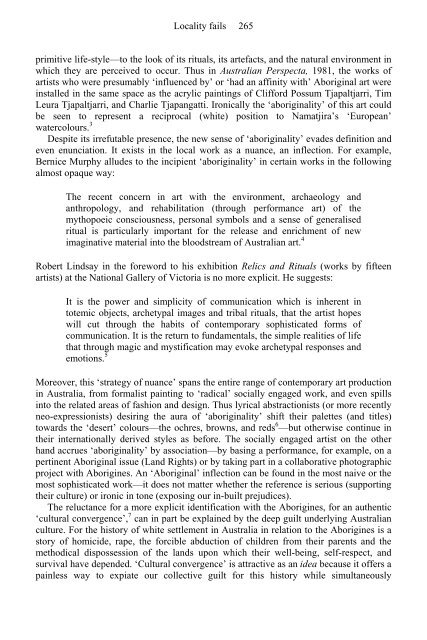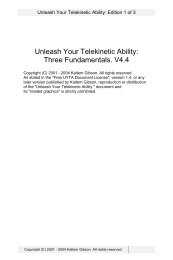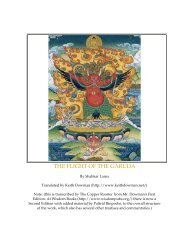Hiller - The Myth of Primitivism. Perspectives on Art - Esoteric Online
Hiller - The Myth of Primitivism. Perspectives on Art - Esoteric Online
Hiller - The Myth of Primitivism. Perspectives on Art - Esoteric Online
Create successful ePaper yourself
Turn your PDF publications into a flip-book with our unique Google optimized e-Paper software.
Locality fails 265<br />
primitive life-style—to the look <str<strong>on</strong>g>of</str<strong>on</strong>g> its rituals, its artefacts, and the natural envir<strong>on</strong>ment in<br />
which they are perceived to occur. Thus in Australian Perspecta, 1981, the works <str<strong>on</strong>g>of</str<strong>on</strong>g><br />
artists who were presumably ‘influenced by’ or ‘had an affinity with’ Aboriginal art were<br />
installed in the same space as the acrylic paintings <str<strong>on</strong>g>of</str<strong>on</strong>g> Clifford Possum Tjapaltjarri, Tim<br />
Leura Tjapaltjarri, and Charlie Tjapangatti. Ir<strong>on</strong>ically the ‘aboriginality’ <str<strong>on</strong>g>of</str<strong>on</strong>g> this art could<br />
be seen to represent a reciprocal (white) positi<strong>on</strong> to Namatjira’s ‘European’<br />
watercolours. 3<br />
Despite its irrefutable presence, the new sense <str<strong>on</strong>g>of</str<strong>on</strong>g> ‘aboriginality’ evades definiti<strong>on</strong> and<br />
even enunciati<strong>on</strong>. It exists in the local work as a nuance, an inflecti<strong>on</strong>. For example,<br />
Bernice Murphy alludes to the incipient ‘aboriginality’ in certain works in the following<br />
almost opaque way:<br />
<str<strong>on</strong>g>The</str<strong>on</strong>g> recent c<strong>on</strong>cern in art with the envir<strong>on</strong>ment, archaeology and<br />
anthropology, and rehabilitati<strong>on</strong> (through performance art) <str<strong>on</strong>g>of</str<strong>on</strong>g> the<br />
mythopoeic c<strong>on</strong>sciousness, pers<strong>on</strong>al symbols and a sense <str<strong>on</strong>g>of</str<strong>on</strong>g> generalised<br />
ritual is particularly important for the release and enrichment <str<strong>on</strong>g>of</str<strong>on</strong>g> new<br />
imaginative material into the bloodstream <str<strong>on</strong>g>of</str<strong>on</strong>g> Australian art. 4<br />
Robert Lindsay in the foreword to his exhibiti<strong>on</strong> Relics and Rituals (works by fifteen<br />
artists) at the Nati<strong>on</strong>al Gallery <str<strong>on</strong>g>of</str<strong>on</strong>g> Victoria is no more explicit. He suggests:<br />
It is the power and simplicity <str<strong>on</strong>g>of</str<strong>on</strong>g> communicati<strong>on</strong> which is inherent in<br />
totemic objects, archetypal images and tribal rituals, that the artist hopes<br />
will cut through the habits <str<strong>on</strong>g>of</str<strong>on</strong>g> c<strong>on</strong>temporary sophisticated forms <str<strong>on</strong>g>of</str<strong>on</strong>g><br />
communicati<strong>on</strong>. It is the return to fundamentals, the simple realities <str<strong>on</strong>g>of</str<strong>on</strong>g> life<br />
that through magic and mystificati<strong>on</strong> may evoke archetypal resp<strong>on</strong>ses and<br />
emoti<strong>on</strong>s. 5<br />
Moreover, this ‘strategy <str<strong>on</strong>g>of</str<strong>on</strong>g> nuance’ spans the entire range <str<strong>on</strong>g>of</str<strong>on</strong>g> c<strong>on</strong>temporary art producti<strong>on</strong><br />
in Australia, from formalist painting to ‘radical’ socially engaged work, and even spills<br />
into the related areas <str<strong>on</strong>g>of</str<strong>on</strong>g> fashi<strong>on</strong> and design. Thus lyrical abstracti<strong>on</strong>ists (or more recently<br />
neo-expressi<strong>on</strong>ists) desiring the aura <str<strong>on</strong>g>of</str<strong>on</strong>g> ‘aboriginality’ shift their palettes (and titles)<br />
towards the ‘desert’ colours—the ochres, browns, and reds 6 —but otherwise c<strong>on</strong>tinue in<br />
their internati<strong>on</strong>ally derived styles as before. <str<strong>on</strong>g>The</str<strong>on</strong>g> socially engaged artist <strong>on</strong> the other<br />
hand accrues ‘aboriginality’ by associati<strong>on</strong>—by basing a performance, for example, <strong>on</strong> a<br />
pertinent Aboriginal issue (Land Rights) or by taking part in a collaborative photographic<br />
project with Aborigines. An ‘Aboriginal’ inflecti<strong>on</strong> can be found in the most naive or the<br />
most sophisticated work—it does not matter whether the reference is serious (supporting<br />
their culture) or ir<strong>on</strong>ic in t<strong>on</strong>e (exposing our in-built prejudices).<br />
<str<strong>on</strong>g>The</str<strong>on</strong>g> reluctance for a more explicit identificati<strong>on</strong> with the Aborigines, for an authentic<br />
‘cultural c<strong>on</strong>vergence’, 7 can in part be explained by the deep guilt underlying Australian<br />
culture. For the history <str<strong>on</strong>g>of</str<strong>on</strong>g> white settlement in Australia in relati<strong>on</strong> to the Aborigines is a<br />
story <str<strong>on</strong>g>of</str<strong>on</strong>g> homicide, rape, the forcible abducti<strong>on</strong> <str<strong>on</strong>g>of</str<strong>on</strong>g> children from their parents and the<br />
methodical dispossessi<strong>on</strong> <str<strong>on</strong>g>of</str<strong>on</strong>g> the lands up<strong>on</strong> which their well-being, self-respect, and<br />
survival have depended. ‘Cultural c<strong>on</strong>vergence’ is attractive as an idea because it <str<strong>on</strong>g>of</str<strong>on</strong>g>fers a<br />
painless way to expiate our collective guilt for this history while simultaneously




